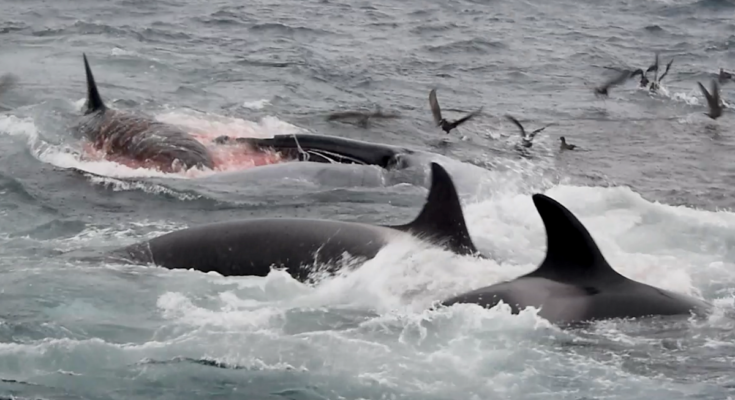
As apex predators, orcas can basically feed on whichever marine animal they want, but biologists weren’t entirely sure if these aquatic killers feast on the biggest of them all: blue whales. New evidence suggests they very much do, and it ain’t pretty.
Warning: This article contains images that may be disturbing.
“Here we provide the first documentation of killer whales killing and eating blue whales,” declare the authors of the new study, published in Marine Mammal Science. The team, which included Robert Pitman from Oregon State University, detailed three different killing incidents, two in 2019 and another in 2021. Importantly, “the first whale taken appeared to be a healthy adult,” the marine biologists write.
The paper describes coordinated attacks, in which packs of mostly females worked together to subdue their prey. Each incident took place in Bremer Bay of Australia, some 40 miles (60 km) from shore, and all observations were made aboard a commercial whale-watching vessel.

“We suggest that the reason attacks on blue whales have been so rarely witnessed—and none fatal—is because commercial whaling in the 1900s nearly exterminated blue whales from the planet,” explained Pitman in an email. “Killer whales that preyed upon them would have had to find other prey or maybe died out also. Either way, the skills and teamwork to take down large whales may have disappeared also.”
That orcas, also known as killer whales, would feed on blue whales is not a huge surprise, as accounts exist of orcas chasing after these majestic giants. These are the first confirmations of successful attacks on Balaenoptera musculus—the largest animal to have ever appeared on Earth. Accordingly, blue whales can now be added to the orca diet, a lengthy list that includes gray whales, bowhead whales, dolphins, squid, octopuses, fish, seals, rays, and even sharks.

The first of the observed attacks happened on March 16, 2019. An apparently healthy adult blue whale measuring between 18 and 22 meters long was attacked by a dozen orcas consisting of eight adult females, one adult male, and some younger members who watched from the sidelines. The scientists’ account of the attack is nothing short of a horror show (warning: a graphic description follows):
After approximately 20 min of continuous attacks by the killer whales, the blue whale slowed and began swimming in a circle with a radius of about 200 m [656 feet]. By 09:20, large chunks of skin and blubber had been stripped off the whale’s flanks behind the dorsal fin; it was bleeding profusely and appeared to be weakening as it continued to reduce its swim speed. A few minutes later, three adult female killer whales lined up, side-by-side, perpendicular to the blue whale, and rammed headlong in its flank, pushing it through the water and then forcing it under. At the same time, two other killer whales were attacking the blue whale’s head, and its forward movement stopped. Moments later, at approximately 09:30, while it was still alive, an adult female killer whale put its head inside the blue whale’s mouth and began feeding on its tongue.
Over 50 orcas would eventually take part in the feeding, as did hundreds of scavenging birds, including shearwaters, petrels, and albatrosses.
“They pick up the scraps during the attack and after the kill. These birds all have a keen sense of smell, and as soon as the killer whales leave the first tooth rake marks on their intended victim, whale oil seeps into the ocean, and the birds start to show up,” said Pitman. “Although a lot less visible, sharks start to collect underwater—I suspect that after all is said and done, the sharks probably consume more of the blue whale than the killer whales will.”
These animals fed on the carcass for days until it finally sank. The scientists returned to the scene six days later, where they saw a large slick on the surface caused by oil trickling up from the carcass below, where undoubtedly other marine animals were now taking advantage of the whale fall.
The second observed attack occurred just a few weeks later, when a pack of 25 orcas, 22 of them females, feasted upon a blue whale calf. A blue whale around one year of age was the subject of the third attack, in which the orcas once again lined-up in coordinated fashion during the account. Pitman says orcas are “intelligent, social creatures” and nothing they do surprises him anymore.

In all three cases, the orcas ate the tongue, which is high in nutritional value. Females, who need to feed their young, were predominantly involved in the attacks as they likely have to feed more frequently, the scientists say.
Speaking to The Guardian, Erich Hoyt, a research fellow at Whale and Dolphin Conservation, said the study confirmed prior suspicions about orca behavior, including the eating of the tongue, which they’re known to do on other whale species. The “excellent photographs in the paper and the extraordinary detail provided by the scientists give us a real insight into how it happens,” he said.
Fascinatingly, healthy humpback whales are “the only baleen whale that appears to be impervious to killer whale attack,” the scientists write, and “it is the only species known to deliberately approach and drive off mammal-eating killer whales, including those attacking other prey.”
The marine biologists will now monitor for similar attacks to determine the extent to which orcas are shaping whale communities now that commercial whaling is, thankfully, nowhere as prevalent as it used to be.
“Now, with the recovery of some blue whale populations, what we may be seeing is killer whales rediscovering a prey base that has largely been absent for the past 50 to 100 years,” said Pitman. “We may also be getting a glimpse of what the ocean looked like before we emptied out most of the large creatures.”



